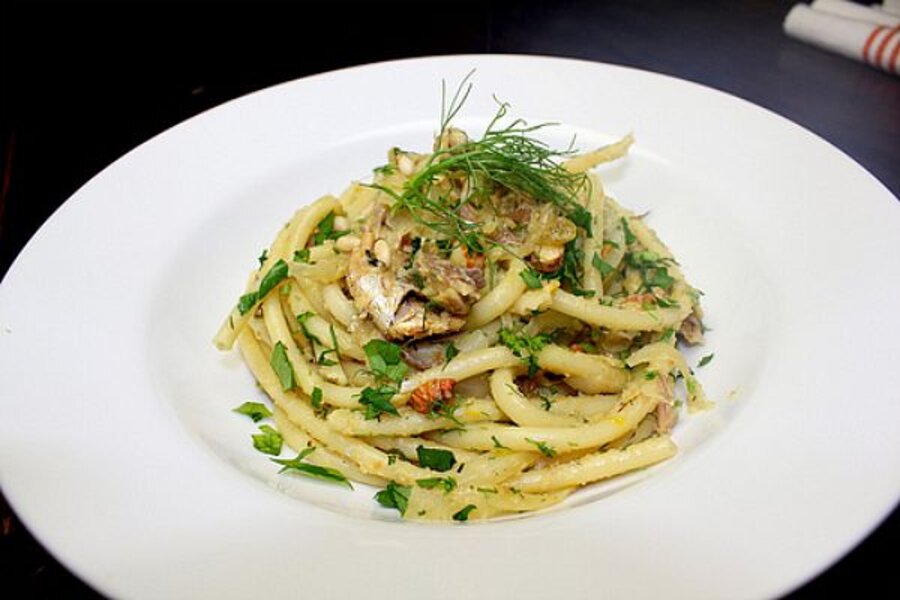Pasta con le Sarde: Sicily on a plate
Greeks, Romans, Moors, Normans, Spaniards, Giuseppe Garibaldi and his thousand, and finally hordes of tourists have visited Sicily over the millennia. Some stayed for centuries, some only for generations, but even those whose sojourn was comparatively brief played a role in the island’s blending of cultures and traditions.
If this human concoction can be distilled into a single dish, it might be pasta con le sarde – long pasta with sardines. A strikingly simple plate of spaghetti, fennel, onions, and sardines garnished with golden raisins (sultanas) and pine nuts, but its layers of flavor and texture speak of Sicily’s multifarious heritage. Grapes, introduced by the Greeks in the 7th century B.C., combining with the tradition of using dried fruit in savory dishes adopted from the Moors, the abundant use of saffron borrowed from the Spanish Bourbon monarchy, and the native reliance on cheap and readily available ingredients of the highest quality in the onions, foraged wild fennel, pine nuts, and the island’s golden olive oil.
And, just like the variegated Sicilian identity, the disagreements over what constitutes a real pasta con le sarde are multihued. Some prefer a thicker long pasta like perciatelli or bucatini over spaghetti, some add breadcrumbs, some refuse to add anchovies, others only saute half the sardines with the sauce, breaking the other half into mix after the pasta has been added to the pan, and yet others would crumble almonds over the assembled dish and bake it in a moderate oven for 20 minutes. The biggest philosophical difference though, lies in the presence of tomato paste. Palermitano’s typically leave it out altogether, whereas cooks further west and south in Trappani, Marsala and, particularly Agrigento, would claim it as an essential ingredient.
Ever the diplomats, we (probably to the aggravation of native Sicilians) chose the middle ground, and elected to use anchovies and bucatini, leave out the tomato paste, cook all the sardines in the sauce, and add both breadcrumbs and broken almonds, but we chose not to bake it. It was wonderful: crunchy, salty and sweet, and with a profound maritime flavor overlaid perfectly by the fennel.
Those of you with an aversion to small, oily fish should probably avoid this dish completely for substitutions of whiter, milder species cannot be recommended, unless even greater Sicilian wrath is desired. And, if encouragement to try something different is needed, look no further than the twin factors of wholesomeness and economy. Sardines and pasta are still very affordable, and, for us, halfway through a month-long meatless regimen ahead of a warm weather vacation, it checked all the taste and healthful boxes.
It also checked the seasonal box, for, strictly speaking, this dish should only be eaten between March and September when wild fennel can be found extending its spidery fronds all over the island’s uplands. For those of us without wild ingredients to hand, or such a favorable climate, cultivated fennel plus a scant 1/4 teaspoon of ground fennel seeds (or a smaller quantity of fennel pollen), provide a similar perfume.
Please note that one should always use the freshest possible sardines, and not just for this recipe. The oilier the fish, the shorter the shelf life – hence why anchovies are so often salted and in oil – and the general rule of thumb is 8-12 hours out of water is about as long as it takes for sardines to go from glorious to gory mess. You can certainly freeze them, too, but like most fish, especially small ones, the defrosting process has to be slow and delicate to prevent them from getting mushy.
Pasta con le Sarde (Long pasta with sardines)
Credit should be given to Ferdinando’s Focacceria for inspiring us to cook this dish.
Serves 4
1 lb. (1/2 kilo) dried long pasta (spaghetti, bucatini, perciatelli)
1 fennel bulb, tops removed and reserved, sliced wafer thin
1 medium yellow onion, sliced thinly
3-4 cloves garlic, finely sliced.
4-6 medium sardines (1 lb. / 1/2 kilo), cleaned and boned
Handful golden raisins (sultanas)
Handful pine nuts (pignoli)
1 small glass dry white wine or cooking wine
2 handfuls day-old bread crumbs
1 handful roughly chopped almonds
3 salted anchovies
1 pinch saffron
Freshly ground black pepper
Sea salt to taste
Good quality olive oil
Chopped flat leaf parsley (optional)
Bring a large pot of salted water to a rolling boil
In a sauté pan, bring 3 tablespoons of olive oil to medium heat
Saute onions, garlic and fennel (not including reserved tops) until softened.
Add sardines and anchovies, stir to break up anchovies.
Turn heat to high and after 30 seconds add white wine or cooking wine and saffron.
Stir again, reduce heat to low after 1 minute. Cover for 5 minutes and allow to steam.
Add pasta to large pot of salted water.
Remove of sauté pan lid, stir sardines so fish starts to flake and fall apart into the sauce.
Add golden raisins and pine nuts. Taste for seasoning, correct accordingly.
When pasta is done – around 7 minutes – scoop a ladle of pasta water into sardine sauce before draining pasta and adding it to sauté pan.
Stir pasta well to coat with sauce. Allow to cook for another minute
Kill heat, and sprinkle in breadcrumbs, chopped almonds, fennel tops and chopped parsley (optional).
Stir well and serve.
Jonny and Amy Seponara-Sills blog at We Are Never Full.
To comment on the original post, click here.
To receive Monitor recipes sign-up here!
--------------------------------------------------------------
The Christian Science Monitor has assembled a diverse group of food bloggers. Our guest bloggers are not employed or directed by The Monitor and the views expressed are the bloggers' own and they are responsible for the content of their blogs and their recipes. All readers are free to make ingredient substitutions to satisfy their dietary preferences, including not using wine (or substituting cooking wine) when a recipe calls for it. To contact us about a blogger, click here.





